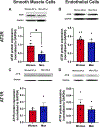Microvascular angiotensin II type 2 receptor function is enhanced in young females and declines in a model of murine aging
- PMID: 40290368
- PMCID: PMC12030185
- DOI: 10.20517/jca.2024.09
Microvascular angiotensin II type 2 receptor function is enhanced in young females and declines in a model of murine aging
Abstract
Introduction: Angiotensin II (AngII) affects cardiovascular health, mediating impacts through AngII type 1 (AT1R) and type 2 (AT2R) receptors. The present study investigated sex and aging-related differences in microvascular AngII receptor function in mice and humans.
Methods: Mesenteric resistance arteries (MRA) were isolated from 3-, 12-, and 18-month-old female and male C57/Bl6 mice. Wire myography was used to measure vasoconstriction to AngII and vasodilation to an AT2R agonist (compound 21, C21). Seven healthy adults (3 premenopausal women and 4 age-matched men) were recruited to participate in a study measuring cutaneous microvascular vasoconstriction to AngII in the presence and absence of 10 μM PD123319, an AT2R antagonist.
Results: In murine MRA, AngII-induced constriction increases by 18 months in females and by 12 months in males. AT2R-mediated vasodilation was reduced with age in females only, which corresponds with a female-specific decrease in mesenteric AT2R mRNA expression. AT2R inhibition enhances AngII-induced constriction in young female, but not male, mice. Clinical data support that premenopausal women have attenuated AngII constriction vs. men, which is abrogated by AT2R inhibition. AT2R expression is greater in primary aortic smooth muscle cells, but not endothelial cells, from young women compared with men.
Conclusions: These data demonstrate enhanced microvascular AT2R function in young female mice and young women. There is a female-specific loss of AT2R function with age in mice, concomitant with declining AT2R expression. These findings implicate AT2R as a sex-specific target for microvascular dysfunction and aging-associated cardiovascular disease.
Keywords: Microvascular function; aging; angiotensin II type 2 receptor; cutaneous; sex differences; skin blood flow.
Conflict of interest statement
Conflicts of interest All authors declared that there are no conflicts of interest.
Figures






Similar articles
-
Angiotensin II type 2 receptor-mediated dilation is greater in the cutaneous microvasculature of premenopausal women compared with men.J Appl Physiol (1985). 2023 Dec 1;135(6):1236-1242. doi: 10.1152/japplphysiol.00382.2023. Epub 2023 Oct 12. J Appl Physiol (1985). 2023. PMID: 37823205 Free PMC article.
-
Pressor responsiveness to angiotensin II in female mice is enhanced with age: role of the angiotensin type 2 receptor.Biol Sex Differ. 2014 Sep 16;5:13. doi: 10.1186/s13293-014-0013-7. eCollection 2014. Biol Sex Differ. 2014. PMID: 25774285 Free PMC article.
-
Pregnancy upregulates angiotensin type 2 receptor expression and increases blood flow in uterine arteries of rats.Biol Reprod. 2018 Nov 1;99(5):1091-1099. doi: 10.1093/biolre/ioy130. Biol Reprod. 2018. PMID: 29860295 Free PMC article.
-
Angiotensin type 2 receptor in hypertensive cardiovascular disease.Curr Opin Nephrol Hypertens. 2011 Mar;20(2):125-32. doi: 10.1097/MNH.0b013e3283437fcd. Curr Opin Nephrol Hypertens. 2011. PMID: 21245762 Review.
-
[Angiogenesis and angiotensin II: differential postnatal angiogenic activities unmasked by gene-engineered mouse models of angiotensin AT1 and AT2 receptor subtypes].Nihon Rinsho. 2002 Oct;60(10):1911-5. Nihon Rinsho. 2002. PMID: 12397683 Review. Japanese.
Cited by
-
The angiotensin II type 2 receptor attenuates aging-associated arterial stiffness in female mice.Am J Physiol Heart Circ Physiol. 2025 Aug 1;329(2):H388-H394. doi: 10.1152/ajpheart.00328.2025. Epub 2025 Jul 7. Am J Physiol Heart Circ Physiol. 2025. PMID: 40623000 Free PMC article.
References
-
- Tsao CW, Aday AW, Almarzooq ZI, et al. Heart disease and stroke statistics-2023 update: a report from the american heart association. Circulation 2023;147:e93–621. - PubMed
-
- DeFilippis EM, Van Spall HGC. Is it time for sex-specific guidelines for cardiovascular disease? J Am Coll Cardiol 2021;78:189–92. - PubMed
Grants and funding
LinkOut - more resources
Full Text Sources
